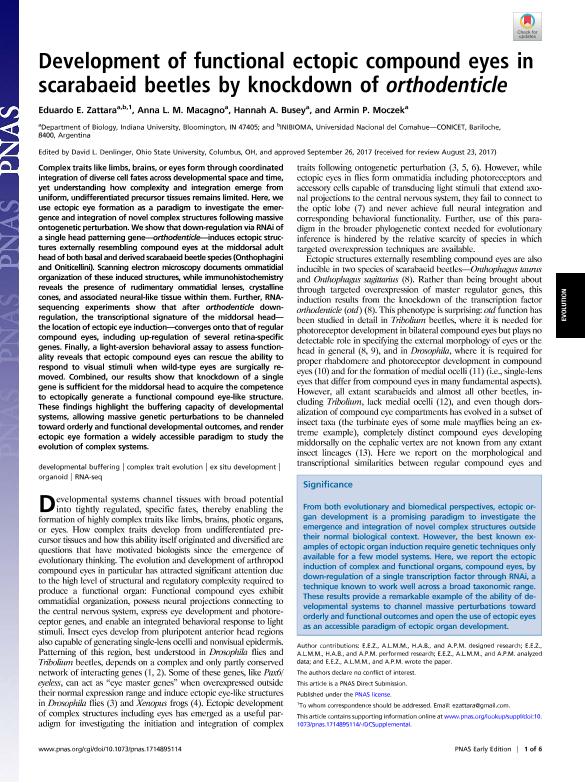Mostrar el registro sencillo del ítem
dc.contributor.author
Zattara, Eduardo Enrique

dc.contributor.author
Macagno, Anna L. M.
dc.contributor.author
Busey, Hannah A.
dc.contributor.author
Moczek, Armin P.
dc.date.available
2018-01-30T16:03:41Z
dc.date.issued
2017-10-01
dc.identifier.citation
Zattara, Eduardo Enrique; Macagno, Anna L. M.; Busey, Hannah A.; Moczek, Armin P.; Development of functional ectopic compound eyes in scarabaeid beetles by knockdown of orthodenticle; National Academy of Sciences; Proceedings of the National Academy of Sciences of The United States of America; 114; 45; 1-10-2017; 12021–12026
dc.identifier.issn
0027-8424
dc.identifier.uri
http://hdl.handle.net/11336/35002
dc.description.abstract
Complex traits like limbs, brains, or eyes form through coordinated integration of diverse cell fates across developmental space and time, yet understanding how complexity and integration emerge from uniform, undifferentiated precursor tissues remains limited. Here, we use ectopic eye formation as a paradigm to investigate the emergence and integration of novel complex structures following massive ontogenetic perturbation. We show that down-regulation via RNAi of a single head patterning gene—orthodenticle—induces ectopic structures externally resembling compound eyes at the middorsal adult head of both basal and derived scarabaeid beetle species (Onthophagini and Oniticellini). Scanning electron microscopy documents ommatidial organization of these induced structures, while immunohistochemistry reveals the presence of rudimentary ommatidial lenses, crystalline cones, and associated neural-like tissue within them. Further, RNA-sequencing experiments show that after orthodenticle down-regulation, the transcriptional signature of the middorsal head—the location of ectopic eye induction—converges onto that of regular compound eyes, including up-regulation of several retina-specific genes. Finally, a light-aversion behavioral assay to assess functionality reveals that ectopic compound eyes can rescue the ability to respond to visual stimuli when wild-type eyes are surgically removed. Combined, our results show that knockdown of a single gene is sufficient for the middorsal head to acquire the competence to ectopically generate a functional compound eye-like structure. These findings highlight the buffering capacity of developmental systems, allowing massive genetic perturbations to be channeled toward orderly and functional developmental outcomes, and render ectopic eye formation a widely accessible paradigm to study the evolution of complex systems.
dc.format
application/pdf
dc.language.iso
eng
dc.publisher
National Academy of Sciences

dc.rights
info:eu-repo/semantics/openAccess
dc.rights.uri
https://creativecommons.org/licenses/by-nc-sa/2.5/ar/
dc.subject
Developmental Buffering
dc.subject
Complex Trait Evolution
dc.subject
Ex Situ Development
dc.subject
Organoid
dc.subject
Rna-Seq
dc.subject.classification
Otras Ciencias Biológicas

dc.subject.classification
Ciencias Biológicas

dc.subject.classification
CIENCIAS NATURALES Y EXACTAS

dc.subject.classification
Otras Ciencias Biológicas

dc.subject.classification
Ciencias Biológicas

dc.subject.classification
CIENCIAS NATURALES Y EXACTAS

dc.subject.classification
Otras Ciencias Biológicas

dc.subject.classification
Ciencias Biológicas

dc.subject.classification
CIENCIAS NATURALES Y EXACTAS

dc.title
Development of functional ectopic compound eyes in scarabaeid beetles by knockdown of orthodenticle
dc.type
info:eu-repo/semantics/article
dc.type
info:ar-repo/semantics/artículo
dc.type
info:eu-repo/semantics/publishedVersion
dc.date.updated
2017-12-15T14:32:54Z
dc.journal.volume
114
dc.journal.number
45
dc.journal.pagination
12021–12026
dc.journal.pais
Estados Unidos

dc.journal.ciudad
Nueva York
dc.description.fil
Fil: Zattara, Eduardo Enrique. Indiana University; Estados Unidos. Consejo Nacional de Investigaciones Científicas y Técnicas. Centro Científico Tecnológico Conicet - Patagonia Norte. Instituto de Investigaciones en Biodiversidad y Medioambiente. Universidad Nacional del Comahue. Centro Regional Universidad Bariloche. Instituto de Investigaciones en Biodiversidad y Medioambiente; Argentina
dc.description.fil
Fil: Macagno, Anna L. M.. Indiana University; Estados Unidos
dc.description.fil
Fil: Busey, Hannah A.. Indiana University; Estados Unidos
dc.description.fil
Fil: Moczek, Armin P.. Indiana University; Estados Unidos
dc.journal.title
Proceedings of the National Academy of Sciences of The United States of America

dc.relation.alternativeid
info:eu-repo/semantics/altIdentifier/url/http://www.pnas.org/lookup/doi/10.1073/pnas.1714895114
dc.relation.alternativeid
info:eu-repo/semantics/altIdentifier/doi/http://dx.doi.org/10.1073/pnas.1714895114
Archivos asociados
